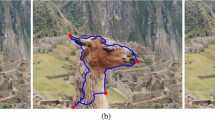Abstract
An interactive framework for soft segmentation and matting of natural images and videos is presented in this paper. The proposed technique is based on the optimal, linear time, computation of weighted geodesic distances to user-provided scribbles, from which the whole data is automatically segmented. The weights are based on spatial and/or temporal gradients, considering the statistics of the pixels scribbled by the user, without explicit optical flow or any advanced and often computationally expensive feature detectors. These could be naturally added to the proposed framework as well if desired, in the form of weights in the geodesic distances. An automatic localized refinement step follows this fast segmentation in order to further improve the results and accurately compute the corresponding matte function. Additional constraints into the distance definition permit to efficiently handle occlusions such as people or objects crossing each other in a video sequence. The presentation of the framework is complemented with numerous and diverse examples, including extraction of moving foreground from dynamic background in video, natural and 3D medical images, and comparisons with the recent literature.
Similar content being viewed by others
References
ADOBE SYSTEMS INCORP. (2002). Adobe photoshop user guide.
ADOBE SYSTEMS INCORP. (2007). Adobe photoshop CS3 new features. http://www.adobe.com/products/photoshop/photoshop.
Agarwala, A., Hertzmann, A., Salesin, D., & Seitz, S. (2004). Keyframe-based tracking for rotoscoping and animation. In Proceedings of SIGGRAPH’04.
Bai, X., & Sapiro, G. (2007). A geodesic framework for fast interactive image and video segmentation and matting. In Proc. international conference computer vision, Rio de Janeiro, Brazil, 16–19 October 2007.
Black, M. J., & Anandan, P. (1996). The robust estimation of multiple motions: parametric and piecewise-smooth flow fields. Computer Vision and Image Understanding, 63(1), 75–104.
Boykov, Y. Y., & Jolly, M.-P. (2001). Interactive graph cuts for optimal boundary and region segmentation of objects in n-d images. In IEEE ICCV 2001 (Vol. 01, pp. 105).
Caselles, V., Morel, J.-M., & Sbert, C. (1998). An axiomatic approach to image interpolation. IEEE Transactions on Image Processing, 7(3), 376–386.
Chuang, Y.-Y., Curless, B., Salesin, D. H., & Szeliski, R. (2001). A Bayesian approach to digital matting. In Proceedings of IEEE CVPR 2001 (Vol. 2, pp. 264–271). December 2001.
Chuang, Y.-Y., Agarwala, A., Curless, B., Salesin, D. H., & Szeliski, R. (2002). Video matting of complex scenes. In SIGGRAPH ’02 (pp. 243–248).
COREL CORPORATION. (2002). Knockout user guide.
Criminisi, A., Cross, G., Blake, A., & Kolmogorov, V. (2006). Bilayer segmentation of live video. In Proceedings of IEEE CVPR 2006 (pp. 53–60).
Dial, R. (1969). Shortest path forest with topological ordering. Communications of the ACM, 12, 632–633.
Falcao, A. X., Stolfi, J., & de Alencar Lotufo, R. (2004). The image foresting transform: Theory, algorithms, and applications. IEEE Transactions on Pattern Analysis and Machine Intelligence, 26(1), 19–29.
Grady, L. (2006). Random walks for image segmentation. IEEE Transactions on Pattern Analysis and Machine Intelligence, 28(11), 1768–1783.
Grady, L., Schiwietz, T., Aharon, S., & Westermann, R. (2005). Random walks for interactive alpha-matting. In Proceedings of VIIP 2005 (pp. 423–429). Spain, September 2005. ACTA Press.
Levin, A., Lischinski, D., & Weiss, Y. (2004). Colorization using optimization. SIGGRAPH’04, 23(3), 689–694.
Levin, A., Lischinski, D., & Weiss, Y. (2006). A closed form solution to natural image matting. In Proceedings of IEEE CVPR 2006 (pp. 61–68).
Levin, A., Rav-Acha, A., & Lischinski, D. (2007). Spectral matting. In Proceedings of IEEE CVPR 2007, June 2007.
Lowe, D. (2004). Distinctive image features from scale-invariant keypoints. International Journal of Computer Vision, 2, 91–110.
Protiere, A., & Sapiro, G. (2007). Interactive image segmentation via adaptive weighted distances. IEEE Transactions on Image Processing, 16, 1046–1057.
Rother, C., Kolmogorov, V., & Blake, A. (2004). Grabcut: Interactive foreground extraction using iterated graph cuts. In SIGGRAPH’04.
Sapiro, G. (2001). Geometric partial differential equations and image processing. Cambridge: Cambridge University Press.
Sinop, A. K., & Grady, L. (2007). A seeded image segmentation framework unifying graph cuts and random walker which yields a new algorithm. In Proc. international conference computer vision, Rio de Janeiro, Brazil, 16–19 October 2007.
Sun, J., Jia, J., Tang, C.-K., & Shum, H.-Y. (2004). Poisson matting. In SIGGRAPH’04 (pp. 315–321).
Sun, J., Kang, S. B., Xu, Z., Tang, X., & Shum, H.-Y. (2007). Flash cut: Foreground extraction with flash and no-flash image pairs. In Proceedings of IEEE CVPR 2007, June 2007.
Thorup, M. (1997). Undirected single source shortest paths in linear time. In Proceedings IEEE symposium on foundations of computer science (pp. 12–21).
Wang, J., & Cohen, M. F. (2005). An iterative optimization approach for unified image segmentation and matting. In Proceedings of IEEE ICCV 2005 (pp. 936–943).
Wang, J., & Cohen, M. (2007a). Image and video matting: A survey. Foundations and Trends in Computer Graphics and Vision, 3(2), 1–78.
Wang, J., & Cohen, M. (2007b). Optimized color sampling for robust matting. In Proceedings of IEEE CVPR 2007, June 2007.
Wang, J., Bhat, P., Colburn, R. A., Agrawala, M., & Cohen, M. F. (2005). Interactive video cutout. SIGGRAPH’05, 24(3), 585–594.
Wang, J., Agrawala, M., & Cohen, M. F. (2007). Soft scissors: An interactive tool for realtime high quality matting. In SIGGRAPH’07.
Yang, C., Duraiswami, R., Gumerov, N., & Davis, L. (2003). Improved fast Gauss transform and efficient kernel density estimation. In Proceedings IEEE ICCV 2003 (pp. 464–471). Nice, France.
Yatziv, L., & Sapiro, G. (2005). Image and video data blending using intrinsic distances. Patent pending.
Yatziv, L., & Sapiro, G. (2006). Fast image and video colorization using chrominance blending. IEEE Transactions on Image Processing, 15(5), 1120–1129.
Yatziv, L., Bartesaghi, A., & Sapiro, G. (2006). O(n) implementation of the fast marching algorithm. Journal of Computational Physics, 212, 393–399.
Virtual colonoscopy screening resource center. (2005) http://www.vcscreen.com.
Author information
Authors and Affiliations
Corresponding author
Rights and permissions
About this article
Cite this article
Bai, X., Sapiro, G. Geodesic Matting: A Framework for Fast Interactive Image and Video Segmentation and Matting. Int J Comput Vis 82, 113–132 (2009). https://doi.org/10.1007/s11263-008-0191-z
Received:
Accepted:
Published:
Issue Date:
DOI: https://doi.org/10.1007/s11263-008-0191-z




